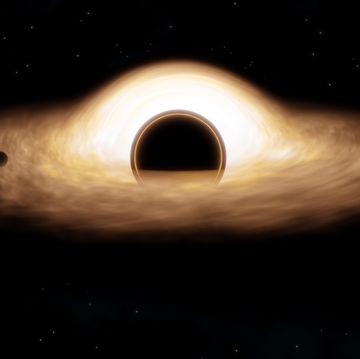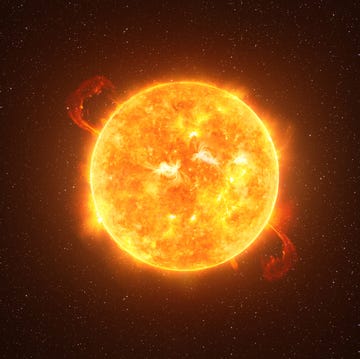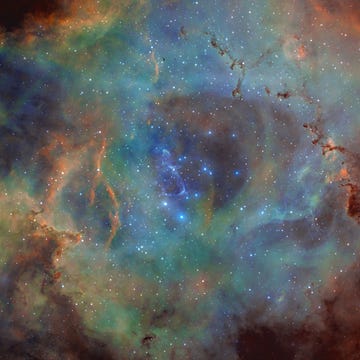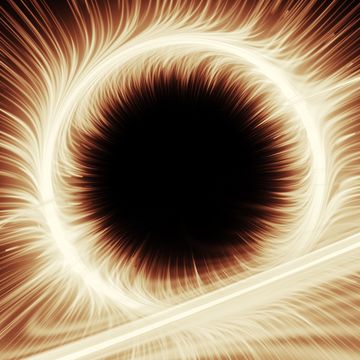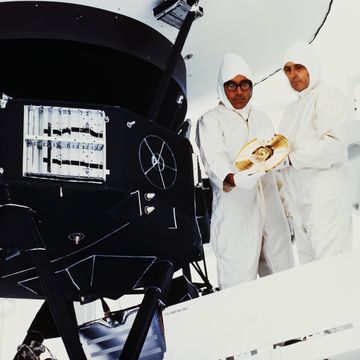Name: Niven Ring, or Ringworld
Named for: Larry Niven's 1970 novel Ringworld and its sequels.
Selected Science Fiction Portrayals: Besides those featured in Niven's novels, similar but smaller structures, called Halos, appear in the Halo video game and media franchise. Also, the Orbitals of Iain M. Banks' Culture novels and short stories.
Someday, when humankind outgrows planet Earth, we might aim to build a habitat so vast we could never overpopulate it.
Sci-fi author Larry Niven conjured up such a megastructure for his award-winning 1970 book Ringworld. Niven imagined a ring with a radius of 93 million miles—the sun-Earth distance—with the sun placed at the center. The ring' would reach 600 million miles across and a million miles tall. The vast landscape could comfortably support perhaps trillions of humans (or another similarly ambitious, technologically advanced race).
"The thing is roomy enough: three million times the area of the Earth. It will be some time before anyone complains about the crowding," Niven wrote in a 1974 essay entitled "Bigger Than Worlds."
Niven figured a Ringworld would have a thickness of a few thousand feet, and require raw materials with a mass equal to that of Jupiter. Mountain "walls" a thousand miles high would line each rim, preventing the atmosphere from leaking into space. The inner surface could be sculpted like Earth's surface—full of great (though shallow) oceans, soaring mountains, and prodigious farmland—or whatever its builders desired.
Could a Ringworld ever be made? While the concept does not bend physics past the point of breaking, it would require truly extreme engineering and an utter mastery of the forces of nature. According to Anders Sandberg, a research fellow at Oxford University's Future of Humanity Institute who has studied megastructure concepts, a Ringworld "is an amazingly large structure that's way beyond what we can normally imagine, but it's also deeply problematic."
Establishing Gravity
When imagining the ring, Niven had started with the concept of a Dyson Sphere, an idea explored by physicist Freeman Dyson a decade prior to Ringworld's publication.
In its usual science fiction presentation as a "ping pong ball around a star," Niven said, a solid Dyson Sphere lacks gravity. Rotating the sphere would create gravity via centrifugal force, but only the equatorial regions would reap the benefits. "So," Niven tells PM, "I just used the equator."
A Niven Ring, then, can be thought of as the slice of the habitat-friendly section of a Dyson Sphere. To get Earth-like gravity, the Ringworld would need to spin at nearly three million miles per hour. Very fast, to be sure. But in a frictionless space environment, it could be doable. The ring could work up to that speed over time and then maintain it with little additional thrusting.
Managing the Sun
Although it would be equidistant from its central star at all points, the Ringworld would not, in fact, be gravitationally stable. Any perturbing force from, say, a meteorite strike or a close encounter with another star could throw the Ringworld out of attractive equilibrium and onto on a cataclysmic collision course. "A Ringworld will tend to drift off whenever it gets a chance," Sandberg says.
Readers of the original Ringworld, including students at the Massachusetts Institute of Technology, wrote letters to Niven about this and other technical issues related to the megastructure. Niven addressed the problem in the 1980 sequel, The Ringworld Engineers. Large rockets placed along the Ringworld's edge would have to periodically fire to keep the megastructure properly situated away from its sun.
For residents of the Ringworld, that sun would always be directly overhead at a perpetual high noon. To create a day–night cycle and save plant life from frying, Niven envisioned a set of "shadow squares" around the sun at about Mercury's distance from Earth. The parts of Ringworld between the squares would experience roving daylight, while the eclipsed portions would rest in the shade. The whole length of the Ringworld would be checkered light and dark. "The builders, if they're something like humans, will want day and night because they will want an imitation of their own planet," Niven says.
The Ringworld's arch, as seen from a great ocean. (Photo Credit: Tim Russell courtesy of larryniven.net)
Solar panels on the immense shadows squares could collect energy to power the structure. Energy could be beamed via laser from the squares to receiver stations along the Ringworld's rim, away from inhabited "land."
Lasers would also come in handy for vaporizing asteroids or comets that might smack into the Ringworld. As a big, thin target, a Ringworld would be devastated by a high-speed impactor. A hole explosively punched through it could let the atmosphere eventually drain out.
Impossible Strength?
Material strength is a potential showstopper for a Ringworld. Because of its bulk, the megastructure would be subjected to mechanical stresses violent enough to break any known physical molecular bonds. "The Ring needs to be superstrong," Sandberg says. "Mere molecular bonds will not do."
For super-strength, the best would bet would be, well, the "strong" force. This force is the grippiest of the four described forces of nature. It has 137 times the strength of electromagnetism, a million times that of the weak force, and duodecillion (1039) times that of puny gravity. Yet it operates only on the femtometer scale of the atomic nucleus. The strong force crams like-charged protons into an atomic nucleus. "The electromagnetic repulsion between the [protons] would love to split them apart, but you have the strong nuclear force gluing them together," Sandberg says.
In our present technological state, we are quite good at manipulating electromagnetism and dealing with gravity. If we could learn to wield the strong force, it would suffice for the structural integrity of a Niven Ring. The strong force is medicated by particles called gluons; if we could rip apart quarks and use their "glue" beyond the nucleic scale, all sorts of architectural and engineering feats would become possible.
"We have no clue how to control the strong nuclear force," Sandberg says, "but it could be that advanced civilizations know how."
Niven avoided this can of worms in his stories by inventing a magic, milky-gray material called "scrith." He envisioned it being somehow producible by transmutation of elements, via high-tech fusion. Transmutation of elements, such as the predominant hydrogen and helium available within Jupiter and Saturn, would be necessary anyhow for enough (non-scrith) material to build the megastructure.
From Worlds to a Ringworld
As for the actual Ringworld building process, Niven sketched it as follows. The solar system's planets would be dismantled by machines and reformatted into disc-shaped plates. Cables would link these plates and, in time, the plates would be pulled together to form a ring.
Given the miracle materials and advanced element transmutation required for a colossal Ringworld, smaller, other ringlike habitats make far more sense from an engineering perspective. The "Halos" in the eponymous video games, for instance, are about 10,000 miles in diameter. They could plausibly be made of steel. Bishop Rings, another proposed ring megastructure by a nanotechnologist, Forrest Bishop, would be a "mere" 1,200 miles in diameter and made of ultra-stiff carbon nanotubes. These rings would not encircle a star or planet, but could nestle stably in a Lagrangian point, where the gravitational pull from a planet matches that of the sun.
A ship swoops toward a Halo ring, under construction. The Ark, a construction and control station for Halos, is seen in the bottom of the image. (Photo Credit: commorancy/Flickr/Wikipedia)
Finally, the rationale for ever pursuing a Ringworld is questionable in the first place. The civilization's rulers would be placing an awful lot of eggs in one basket. A catastrophic failure somewhere on the Ring, perhaps of a stabilizing thruster, could doom the entire venture, and its trillion of inhabitants. (Niven explores this kind of crisis in The Ringworld Engineers.)
Niven himself points out that Ringworlds are really for telling a good story rather than offering a prescription for an Earth whose population has runneth over.
"Even if we go for big stuff, there is no reason to build a Ringworld," Niven says, "when we could build a million [other] things and put them in orbit, rather than in orbit around the sun."




